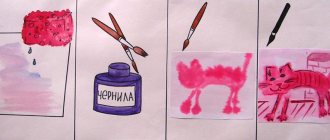The coherent speech of a preschooler is a significant indicator of his speech and general development. If a child reveals the meaning well in a conversation, logically and consistently talking about something, then adults note that he speaks coherently and coherently. At the same time, do not forget to note the mental development of the baby.
It is gratifying that the ability to speak meaningfully and understandably is developed through training. This means that parents and educators can help a preschooler get comfortable using their native language.
What kind of speech of a preschooler is called coherent?
The coherence of statements is not a randomly occurring characteristic. This is the result of the development of cognitive processes, enrichment of vocabulary and mastery of grammatical fundamentals.
Inspiration
The speech of a preschooler acquires coherence if it is filled with semantic content. And meaning appears only when sentences are constructed using appropriate words and taking into account the rules of grammar.
The first sentence is followed by the second, third... All together they reveal the content of the speaker’s thoughts or intentions.
A simple chain for an adult. But the preschooler has yet to learn to put the need to speak into understandable verbal forms.
Connected speech is a form of oral speech consisting of successive logical statements that reveal the content and meaning of a certain thought.
The development of coherent speech in preschool children is a qualitatively new stage. By learning to express his thoughts logically and consistently, a preschooler acquires the main new development in speech development.
Coherent speech as a result of thinking
Coherent speech is the result of human thinking. If a child is able to think coherently, then his speech will also be coherent. If you carefully analyze a child’s speech, you can understand what are the features of his logical thinking, his ability to think about what he has perceived, his skills of formatting his thoughts into speech that is understandable to others.
If a child is able to coherently and accurately express his thoughts in words, formalizing them in a literary text, then this has a powerful impact on the formation of the preschooler’s aesthetic perception: when retelling the works he has heard, the preschooler uses figurative expressions in his speech and repeats artistic techniques after the author to describe this or that events or phenomena.
If a child has learned to speak coherently, this greatly helps him in communicating with other people, it prevents the tendency to silence and shyness, such children are quite confident in themselves.
A child’s coherent speech is characterized by the fact that its form and content are unified with each other. If a child belittles the semantic load of speech, this can lead to the dominance of its external manifestation over the internal one.
This means that the rules of grammatical structure are absorbed by a preschooler much faster than the logic of constructing speech utterances. It is difficult for such children to choose the most appropriate words; they often use words incorrectly and do not know how to explain their meaning.
On the other hand, the formal (external) side of speech should also not be underestimated. When a child acquires new knowledge and enriches his ideas, he must be able to correctly express them in verbal statements.
We understand by coherent speech the presentation of thoughts in an expanded form, which is subject to the laws of logic, consistency and accuracy, as well as the competent formulation of these thoughts into speech.
Stages of formation of coherent speech in preschool age
The formation of speech - not only coherent, but also situational - in a child progresses in stages. Features of the speech development of preschool children are determined by the dominant type of thinking.
At 3-4 years old , a child develops visually effective thinking, and his speech practice is firmly tied to specific objects and situations. The younger preschooler already speaks, but in simple phrases using indefinite forms of pronouns and adverbs (that, there).
Read more about how speech development progresses in children 3-4 years old.
Coherent speech first appears in communication with adults and peers. An important condition for its formation is orientation towards the listener and the desire to speak in such a way that the listener understands.
No matter how small a preschooler is, he is faced with the task of acquiring the skills to clearly express the essence of what worries, interests, and worries him. Only in this way can the communicative function of speech be realized.
Signs of coherence appear due to the filling of the active vocabulary and the initial development of the grammatical structure of oral speech. Skills of free use of words are formed. Fragmentary statements are replaced by more detailed sentences.
There comes a period when we can distinguish two forms of coherent speech in preschoolers:
- contextual;
- explanatory.
By the age of 5, the child begins to compose complex sentences that sound like a set of simple ones. For example, five-year-old Katya enthusiastically describes what she just saw: “The duckling jumped into the water, then he swam, and the mother duck led all the ducklings to the shore.” In such statements, the grammatical structure of speech is already clearly manifested.
At this age, the preschooler describes visual situations well. He uses correct sentence structure and tries to present a complete picture of what he saw or heard about. In this case, the preschooler may “lose” the subject or predicate, but his speech is understandable in this context. Therefore, such speech is called coherent contextual.
A six-year-old child, in accordance with the norms of speech development, must actively use detailed statements and use linguistic means, such as comparisons and epithets. What most children cope with successfully. Their conversations are full of made-up stories.
Lenya says: “Look, I’m jumping like a bunny. It's my birthday, forest dwellers came to visit me and brought me a lot of delicious sweet carrots. And I will treat my guests to what they love.”
The coherent speech of children of senior preschool age is based on imaginative thinking. They imagine images and describe their characteristics, or remember events and give details. Older preschoolers use the most complex form of coherent speech - explanatory. Characteristic features are the logical unification of all parts of the message and the reflection of cause-and-effect relationships.
Speech and thinking
The child’s mental activity develops very quickly. This has a powerful effect on the level of formation and speech too. The content of the speech becomes rich, the form is literate and understandable. Children begin to cope well with identifying more significant details in phenomena and objects.
In older preschool age, children love to take part in conversations. They have primary skills in arguing, are able to reason, are highly motivated to defend their own point of view, and in some cases try to convince a peer of something. They now not only name an object or phenomenon, but also describe their qualities and properties, and are also able to highlight their most important features. They are able to conduct oral analysis of phenomena and objects.
The fact that children are already able to establish connections between objects is manifested in their monologues.
Children are able to be selective in choosing new knowledge, and also select a more appropriate form of statements during the story. They are increasingly able to use complex sentences in their speech, so there is a shift in attention towards them from simple and incomplete ones.
Children also begin to correctly compose plot stories. They also manage to work well with writing descriptive stories. However, they still need the teacher to show them an example of how to do it first. Difficulties are caused by the task of expressing in your story the emotional perception of the described object, phenomenon or situation.
Dialogue and monologue in coherent speech of preschoolers
Language acquisition is realized through two main speech forms: dialogical and monologue.
Dialogical speech is primary in the development of a child. The children's vocabulary consists of a small number of words, and sentences have a simple structure. A preschooler learns to express a request to someone with whom he is working together, learns to answer questions, ask them and perceive the answers.
At first, for many children, even simple treatment seems overwhelming. The adult shows the child an example of how to make a request to a peer, and then encourages him to repeat it. To involve a preschooler in a dialogue, an adult asks him questions, asks him to talk about everyday events (where he was, what he saw, etc.). Thanks to the interlocutor's remarks, the little storyteller develops a coherent description.
Fascinating dialogue
As the child grows up, dialogues become longer and logically connected. When talking with a preschooler, an adult asks him about his impressions, about the qualities of objects or phenomena, trains the ability to give detailed answers, and observe the sequence of remarks. Older preschoolers use a similar practice in communicating with peers.
Monologue speech is a more voluminous and lengthy statement than a dialogue line. A monologue is subject to logic and expresses in detail the thought or opinion of one person. It can take the form of a story about some events. Can describe phenomena or objects. Often sounds like reasoning or persuasion.
The importance of monologue speech for a preschooler lies in the fact that the child learns to adhere to the chosen topic and logically structure his statement. In a monologue there is a “coherence of thoughts”, which ensures the coherence of speech.
Preschoolers begin to use monologue as soon as they become interested in the game. Girls like to talk edifyingly to their dolls, imagining educational moments. Boys can play with a car for a long time and at the same time voice their actions, talk with imaginary fellow travelers, traffic inspectors, etc. Such simple monologues contribute to the formation of coherent speech.
Coherence in spoken language
The simplest and most elementary speech is colloquial speech. As a rule, it occurs between two or more interlocutors. This speech is situational in nature. It is usually emotional, since people perceive each other very well, interact with each other not only with verbal statements, but with facial expressions and gestures, as well as the pace of speech, intonation and its other properties. Usually, during a conversation, a familiar topic is discussed.
The syntax of such speech is also very simple: people tend to use unfinished sentences, often ask and answer questions, and make short remarks.
Despite its simplicity, colloquial speech must also meet certain requirements: it must be understandable to another person, logically consistent - only in this case will it cope with its task of communication. Preschoolers are able to master spoken language well only under the guidance of an adult.
Techniques for developing coherent speech in preschoolers
A growing child develops internal motives to master their native language better and more deeply. The preschooler is interested in many things, and there is a desire to ask and tell more. There is a need to influence the interlocutor, express your opinion, argue.
This means that the relevance of the development of coherent speech in preschoolers is supported by favorable conditions - an adult offers to help the child learn to speak logically and clearly, to which he receives a lively response.
There are proven methods and techniques that stimulate the speech development of preschool children. These include:
- retelling;
- stories based on pictures;
- writing fairy tales and stories.
Teaching preschoolers retelling
It would seem that retelling is the simplest speech training. You don’t need to invent anything, just remember what the text says and convey it in your own words. But a preschooler doesn’t have that many words in stock!
We read, we retell...
Children's literature is written in accessible language, but necessarily covers the child's vocabulary. Therefore, in order to convey content, children, along with known words, need to use new concepts.
It is even more difficult to adhere to the course of events presented in the plot. A preschooler is required to be able to comprehend what and how is happening to the main characters in order to tell everything coherently.
It is convenient to solve the problem of how to teach a child to retell a text in the following sequence:
- Read an interesting story or fairy tale.
- Clarify the child’s impressions (whether he liked it or not, what characters or events interested him).
- Pay attention to new concepts and talk about them together.
- Invite the preschooler to tell this fairy tale, story (present in a playful way, and not as a retelling task).
- “Do you remember how it all began?” - read the first lines. Typically, the little listener will soon interrupt and begin to convey the content.
- The adult constantly supports the narrator, encourages him to continue with hints: “What happened next?”, “Where did they go?”, “What was it like at that time?”, etc.
- Having completed the retelling, praise the child and pay attention to the moral that is necessarily contained in children's stories: whether this or that hero did well.
The proposed procedure for teaching retelling should be applied when the formation of coherent speech in preschool children is just beginning. Older preschoolers can master independent retellings if they first make a plan of what the story will be about. To tell a story according to plan, it is necessary to highlight several key events in the overall storyline.
Development of coherent speech based on pictures
The skill of coherent statements using visual material is successfully trained. These can be single pictures, as well as a series of images that reflect the development of the plot.
The preschooler is asked to tell:
- What is shown in the picture.
- What events happened before?
- How will the situation develop further?
When using pictures, it should be taken into account that older preschoolers enthusiastically fantasize and use detailed explanations based on images. But the presence of pictures increases the situational nature of speech in younger preschoolers - instead of describing, they can point to the details depicted.
Fairy tale and speech
Seven-year-old children, after listening to a fairy tale, are able to invent fairy tales themselves, in which they endow various characters with fantastic abilities.
At this age, children are able to build a competent structure when composing a story based on a plot; they are able to create a denouement and include the direct speech of the characters in the content. However, the content of stories at this age is not always logical and diverse.
The fact that in preschool age children often engage in independent activities leads to the fact that children begin to develop the intellectual functions of speech: they are able to reason, explain how to act correctly, and plan something step by step.
It turns out that the child’s coherent speech acquires new functions - the child begins to plan his activities and regulate them with the help of speech. By the first grade of school, children master all types of speech activity that are available to adults.
It is worth noting that children will only fully master coherent speech if they are purposefully taught this. Important conditions for a successful result are: the development of motivation, the formation of the need for monologue speech, the development of self-control, and mastery of existing syntactic means for constructing detailed statements.
Forming coherent speech by writing stories
Essays develop imagery, logic, and expressiveness of statements. By writing stories we mean any stories told by a preschooler.
The more vocabulary a child has, the easier it is for him to express his impressions and fantasies. The finished story contains a number of supporting points, which preschoolers are guided by in the retelling, and in the stories they compose, they freely build all the plot twists.
Story-writing skills begin to develop when the child is asked to describe what he saw on a walk, in the park, or on the playground. Middle-aged and older preschoolers willingly tell episodes from their lives - where they visited, with whom and how they spent time.
The development of coherent speech in preschool children occurs not only in specially organized conditions, when the child is asked to retell, describe, or invent. Every day, in communication and play, children use contextual and explanatory speech, replenish their vocabulary, which increases their speech level.
Age-related features of speech in children
Children under three years old are very easily distracted from conversations. Their participation in dialogical speech largely depends on the development of memory, thinking abilities, vocabulary and the degree of mastery of the grammatical structure of speech.
At the age of 4-5, children gradually begin to use fragmentary statements less and less often, and are increasingly consistent in their reasoning. They often ask various questions. At five years old, a child can already talk for a long time with an interlocutor. At this time, he can ask questions, listen to answers, and answer the interlocutor’s questions himself.
Concept, forms and functions of coherent speech
The influence of Russian folk tales on the development of coherent speech in children of senior preschool age Read more: Features of the development of coherent speech in preschool children
1.1 Concept, forms and functions of coherent speech
Coherent speech is understood as a semantically expanded statement (a series of logically combined sentences) that ensures communication and mutual understanding. Coherence, Rubinstein believed, is “the adequacy of the speech formulation of the speaker’s or writer’s thoughts from the point of view of its intelligibility for the listener or reader” [1, p. 245]. Therefore, the main characteristic of coherent speech is its intelligibility for the interlocutor
Coherent speech is a speech that reflects all the essential aspects of its subject content. Speech can be incoherent for two reasons: either because these connections are not realized and not represented in the speaker’s thoughts, or because these connections are not properly identified in his speech.
In the methodology, the term “coherent speech” is used in several meanings: 1) process, activity of the speaker; 2) product, the result of this activity, text, statement; 3) the title of the section of work on speech development. The terms “statement” and “text” are used synonymously. An utterance is both a speech activity and the result of this activity: a specific speech product, greater than a sentence. Its core is meaning (T.A. Ladyzhenskaya, M.R. Lvov and others). Coherent speech is a single semantic and structural whole, including interconnected and thematically united, complete segments [4, p.44].
The main function of coherent speech is communicative. It is carried out in two main forms - dialogue and monologue. Each of these forms has its own characteristics, which determine the nature of the methodology for their formation.
In linguistic and psychological literature, dialogical and monologue speech are considered in terms of their opposition. They differ in their communicative orientation, linguistic and psychological nature.
Dialogical speech is a particularly striking manifestation of the communicative function of language. Scientists call dialogue the primary natural form of linguistic communication, the classical form of verbal communication. The main feature of the dialogue is the alternation of speaking by one interlocutor with listening and subsequent speaking by the other. It is important that in a dialogue the interlocutors always know what is being said and do not need to develop thoughts and statements. Oral dialogic speech occurs in a specific situation and is accompanied by gestures, facial expressions, and intonation. Hence the linguistic design of the dialogue. Speech in it may be incomplete, abbreviated, sometimes fragmentary. The dialogue is characterized by: colloquial vocabulary and phraseology; brevity, reticence, abruptness; simple and complex non-union sentences; brief premeditation. The coherence of the dialogue is ensured by two interlocutors. Dialogue speech is characterized by involuntary and reactive behavior. It is very important to note that dialogue is characterized by the use of templates and clichés, speech stereotypes, stable communication formulas, habitual, often used and seemingly attached to certain everyday situations and topics of conversation (L.P. Yakubinsky) [1, p. 247]. Speech clichés make dialogue easier.
Monologue speech is a coherent, logically consistent utterance that lasts a relatively long time and is not designed for an immediate reaction from listeners. It has an incomparably more complex structure and expresses the thought of one person, which is unknown to the listeners. Therefore, the statement contains a more complete formulation of information, it is more detailed. A monologue requires internal preparation, longer preliminary thinking about the statement, and concentration of thought on the main thing. Here, too, non-verbal means (gestures, facial expressions, intonation), the ability to speak emotionally, vividly, and expressively are important, but they occupy a subordinate place. A monologue is characterized by: literary vocabulary, detailed utterance, completeness, logical completeness; syntactic design (extensive system of connecting elements); the coherence of the monologue is ensured by one speaker [1, p. 248].
These two forms of speech also differ in motives. Monologue speech is stimulated by internal motives, and its content and linguistic means are chosen by the speaker himself. Dialogical speech is stimulated not only by internal, but also by external motives (the situation in which the dialogue takes place, the interlocutor’s remarks).
Consequently, monologue speech is a more complex, arbitrary, more organized type of speech and therefore requires special speech education.
Despite significant differences, dialogue and monologue are interconnected. In the process of communication, monologue speech is organically woven into dialogic speech, and a monologue can acquire dialogical properties. Often communication takes place in the form of a dialogue with monologue inserts, when, along with short remarks, more detailed statements are used, consisting of several sentences and containing various information (message, addition or clarification of what was said). L.P. Yakubinsky, one of the first researchers of dialogue in our country, noted that extreme cases of dialogue and monologue are interconnected by a number of intermediate forms. One of the latter is a conversation, which differs from a simple conversation in the slower pace of exchange of remarks, their larger volume, as well as the deliberation and arbitrariness of speech. Such a conversation is called a prepared dialogue in contrast to a spontaneous (unprepared) conversation.
The relationship between dialogic and monologue speech is especially important to take into account in the methodology of teaching children their native language. It is obvious that the skills and abilities of dialogical speech are the basis for mastering a monologue. In the course of teaching dialogical speech, the prerequisites are created for mastering narration and description. This is also helped by the coherence of the dialogue: the sequence of remarks determined by the topic of the conversation, the logical and semantic connection of individual statements with each other. In early childhood, the formation of dialogic speech precedes the formation of monologue, and later work on the development of these two forms of speech proceeds in parallel.
A number of scientists believe that although mastering elementary dialogic speech is primary in relation to monologue and prepares for it, the quality of dialogic speech in its mature, developed form largely depends on mastery of monologue speech. Thus, teaching elementary dialogic speech should lead to mastery of a connected monologue utterance and because the latter could be included in an expanded dialogue as early as possible and would enrich the conversation, giving it a natural, coherent character [4, p. 45].
Coherent speech can be situational and contextual. Situational speech is associated with a specific visual situation and does not fully reflect the content of thought in speech forms. It is understandable only when taking into account the situation being described. The speaker widely uses gestures, facial expressions, and demonstrative pronouns. In contextual speech, unlike situational speech, its content is clear from the context itself. The difficulty of contextual speech is that it requires constructing a statement without taking into account the specific situation, relying only on linguistic means.
In most cases, situational speech has the nature of a conversation, and contextual speech has the nature of a monologue. But, as D.B. Elkonin emphasizes, it is wrong to identify dialogical speech with situational speech, and contextual speech with monological speech. And monologue speech can be situational in nature [1, p. 45].
It is important in connection with the discussion of the essence of connected speech to understand the concept of “spoken speech”. Children of preschool age master, first of all, a conversational style of speech, which is characteristic mainly of dialogic speech. Monologue speech in a conversational style is rare; it is closer to the bookish literary style.
In the pedagogical literature, the special role of coherent monologue speech is often emphasized, but mastering the dialogical form of communication is no less important, since in a broad sense “Dialogical relationships... are an almost universal phenomenon that permeates all human speech and all relationships and manifestations of human life” (M.M. Bakhtin) [1, p. 249].
The development of both forms of coherent speech plays a leading role in the process of the child’s speech development and occupies a central place in the overall system of work on speech development in kindergarten. Teaching coherent speech can be considered both as a goal and as a means of practical language acquisition. Mastering different aspects of speech is a necessary condition for the development of coherent speech, and at the same time, the development of coherent speech contributes to the child’s independent use of individual words and syntactic structures. Coherent speech absorbs all the child’s achievements in mastering his native language, its sound structure, vocabulary, and grammatical structure.
Coherent speech performs the most important social functions: it helps the child establish connections with people around him, determines and regulates the norms of behavior in society, which is a decisive condition for the development of his personality.
Teaching coherent speech also has an impact on aesthetic education: retellings of literary works and independent children’s compositions develop imagery and expressiveness of speech, enriching children’s artistic and speech experience.
Depending on the function, four types of monologues are distinguished: description, narration, reasoning and contamination (mixed texts). In preschool age, predominantly contaminated statements are observed, in which elements of all types can be used with a predominance of one of them. The teacher must be well aware of the features of each type of text: their purpose, structure, their characteristic language means, as well as typical interphrase connections.
Description is a static characteristic of an object. In the description, a general thesis is highlighted that names the object, then there is a description of essential and secondary features, qualities, and actions. The description ends with a final phrase expressing an evaluative attitude towards the subject.
A narrative is a coherent story about some events. Its basis is a plot unfolding over time. Narration serves to tell about developing actions and states (narration about facts, events, state and mood, experiences).
Reasoning is a logical presentation of material in the form of evidence. The reasoning contains an explanation of a fact, argues a certain point of view, and reveals cause-and-effect relationships and relationships.
Retelling is a meaningful reproduction of a literary text in oral speech. This is a complex activity in which the child’s thinking, memory and imagination are actively involved. To master a retelling, a number of skills are required, which children are taught specifically: listening to a work, understanding its main content, remembering the sequence of presentation, speech patterns of the author’s text, conveying the text meaningfully and coherently.
Retelling works of fiction has a positive effect on the coherence of children's speech. Children follow the model of literary speech and imitate it. The texts contain figurative descriptions that arouse children’s interest, develop the ability to describe objects and phenomena, improve all aspects of speech, and sharpen interest in language.
A story is a child’s independent, detailed presentation of certain content.
The problem of developing coherent speech in preschool children was of great importance in the works of domestic and foreign teachers.
1. 2 The problem of developing coherent speech in the works of teachers
We find attention to the problem of developing coherent speech in preschool children in the works of the Czech humanist teacher Jan Amos Comenius (1592-1672), who proposed using artistic stories, fables, and fairy tales about animals in working with children as a means of developing coherent speech. The development of coherent speech, in his opinion, begins with a clear, correct naming of objects: you need to teach the things themselves, and not the words that denote them.
Close to the works of J. A. Komensky in terms of teaching content and methodological recommendations are the works of the Swiss teacher Johann Heinrich Pestalozzi (1746-1827). In teaching coherent speech, he established the following sequence: knowledge of the appearance of objects, their distinctive features based on perception, selection of a number of words to characterize an object, classification of words and objects, composing and distributing sentences, explaining the meanings of words, composing coherent texts. The exercises developed by Pestalozzi simultaneously developed cognitive abilities [1, p.27].
A continuation of progressive pedagogical ideas was the system of teaching the native language, developed by the outstanding Russian teacher Konstantin Dmitrievich Ushinsky. K.D. Ushinsky saw three goals in the initial teaching of children’s native language. The first is to develop the gift of speech, that is, the ability to express one’s thoughts. For this, it is important that the teaching be visual and rely on specific images perceived by the child (natural phenomena, paintings). The second goal is to teach the child to put his thoughts into the best possible form. Ideal examples of this form are works of art, both folk and original. K.D. Ushinsky clearly defined the requirements for the selection of works for children: positive ideas, artistry, accessibility of content. He was the first to develop a system of children's reading. In the children's reading circle, the great teacher included folk tales, riddles, jokes, proverbs, works of Russian writers and his own. The third goal is the practical mastery of grammar, which precedes the study of it as a science. A variety of exercises can serve this purpose - coming up with sentences with a given word, selecting words in the right form, and more. All three goals must be achieved simultaneously.
K.D. Ushinsky made a great contribution to the methods of developing coherent speech in preschool children. In modern practice, kindergartens widely use exercises, stories written by him, and folk tales in his adaptation [4, p. 15].
A direct student and follower of K.D. Ushinsky was Elizaveta Nikolaevna Vodovozova (1844-1923), a well-known children's writer and teacher in those years. Following her teacher E.N. Vodovozova, she believed that education should be based on folk speech and folk art. She considered the development of coherent speech and thinking in close connection with the accumulation of sensory experience. In her work “Mental Development of Children from the First Appearance of Consciousness to the Age of 8,” E.N. Vodovozova outlined a program for the development of native coherent speech in children and a methodology for using Russian folklore. Here she outlined in detail her views on the fairy tale and proposed a series of fairy tales accessible to preschoolers. In her opinion, a fairy tale should be based on children's experience, develop children's imagination, and enrich speech with folk phrases and expressions. Recommendations on the selection of fairy tales were valuable. She suggested telling many fairy tales to children in a special way, in an abbreviated form.
The work of Elizaveta Ivanovna Tikheyeva (1867-1944), a well-known public figure in the field of preschool education, had a huge influence on the content and methods of work on the development of coherent speech in children. E.I. Tikheeva considered the development of coherent speech and teaching her native language in connection with personality development. “The ability to articulate speech is one of the most significant and characteristic manifestations of human personality. Developing speech contributes to the development of the personality as a whole, and any aspect of personality development contributes to the development of language.” Hence, in her opinion, systematic teaching of coherent speech should form the basis of the entire system of education in kindergarten. She has developed and presented types of children's storytelling: stories by title, by the beginning of the story, by pictures, from experience, and others [1, p. 32].
The doctor of pedagogical sciences, professor, head had a significant influence on the methods of developing coherent speech. Department of Preschool Pedagogy, MPGI named after. V.I.Lenina Evgenia Aleksandrovna Flerina (1889-1952). Of great interest are E.A. Flerina’s thoughts on teaching children dialogical speech. Without diminishing the role of the monologue, she pointed out that life is permeated with dialogic interactions between the teacher and children, and children with each other. Based on long-term research and teaching experience, E.A. Flerina emphasized the role of a relaxed atmosphere in communication, the need for special conversations with children, and proposed her own classification and methodology of conversations [1, p. 33].
Olga Ivanovna Solovyova dealt with the problem of developing coherent speech in preschool children. Heading for many years the Central Scientific and Methodological Office for Preschool Education of the Ministry of Education, Olga Ivanovna did a lot to improve the work of kindergartens on speech development, and later, in 1956, she prepared the first textbook on methods for preschool teacher training colleges, which covers the development of all aspects speech, including the development of coherent speech in preschoolers.
The problem of the development of coherent speech in preschool children was dealt with by A.P. Usova, L.A. Penyevskaya, A.M. Borodich, R.I. Zhukovskaya, V.I. Loginova, F.A. Sokhin - a student of S.L. Rubinstein , a deep expert in children's speech, linguist and psychologist.
Maria Mitrofanovna Konina (1913-1991) - a direct student of E.A. Flerina, for almost 40 years she taught a course in speech development methods at the Moscow State Pedagogical Institute. V.I.Lenin. MM. Konina continued to develop her teacher’s ideas in the field of artistic reading and storytelling to children. This problem was central to her research. She deepened approaches to the use of fiction as a means of mental, speech, moral and aesthetic education.
The problem of children's speech development was also studied in the preschool education sector of the Research Institute of Schools of the RSFSR under the leadership of Galina Mikhailovna Lyamina. Psychological and pedagogical research became the basis for the development of speech standards for children of different age groups. Psychological and pedagogical studies of children's speech are carried out in three directions (according to the classification of F.A. Sokhin):
1) structural – questions of the formation of different structural levels of the language system are studied: phonetic, lexical and grammatical;
2) functional – the problem of developing language skills in the communicative function is studied;
3) cognitive – the problem of forming elementary awareness of the phenomena of language and speech is explored.
The second direction is represented by research into the pedagogical conditions for the formation of coherent speech, which is considered as a phenomenon that absorbs all the achievements of the mental and speech development of children.
Research in the field of coherent speech in the 60-70s was largely determined by the ideas of E.I. Tikheeva and E.A. Flerina. They clarified the classification of children's stories and methods of teaching different types of storytelling in age groups (N.A. Orlanova, O.I. Konenko, E.P. Korotkova, N.F. Vinogradova).
Approaches to the study and development of coherent speech have been influenced by research in the field of text linguistics. In studies carried out under the guidance of F.A. Sokhin and O.S. Ushakova (G.A. Kudrina, L.V. Voroshnina, A.A. Zrozhevskaya, N.G. Smolnikova, E.A. Smirnova, L. G. Shadrina), the focus is on the search for clearer criteria for assessing the coherence of speech. The main indicator is the ability to structure a text and use various methods of connections between phrases and parts [1, p.50].
The influence of Russian folk tales on the development of coherent speech in children of senior preschool age Read more: Features of the development of coherent speech in preschool children
Information about the work “The influence of Russian folk tales on the development of coherent speech in children of senior preschool age”
Section: Pedagogy Number of characters with spaces: 174624 Number of tables: 3 Number of images: 4
Similar works
Russian folk tale as a means of developing figurative speech in children of senior preschool age
77690
1
2

..., and the presence of these means of imagery in the text of a Russian folk tale, we will identify the possibilities of using Russian folk tales as a means of developing figurative speech in older preschoolers. 1.3 Russian folk tale as a means of developing figurative speech in children of senior preschool age Russian folk tale, being understandable to a child of senior preschool age, is ...
Fairy tales as a means of developing coherent speech in children aged 4-5 years
156265
35
0
... statements. Having examined the questions of the first chapter, we can conclude that the fifth year of life is a period of high speech activity in children and intensive development of all aspects of their speech. Chapter II. Fairy tale as a means of developing coherent speech in children of middle preschool age §1. Fairy tale as a genre of fiction Fairy tale, folk tale, is a narrative folklore genre. This …
The method of modeling fairy tales as a means of developing the speech of children of senior preschool age
71334
0
0
... List of documents and materials. 1. Statement. 2. Attestation sheet. 3. Attestation card. 4. Characteristics. 5. Experimental and methodological work “Method of modeling fairy tales as a means of developing children’s speech.” 6. Lesson notes. 7. Diagnostics. 8. Long-term planning. 9. Questionnaire for parents. 10. Feedback from parents about the work of the teacher. eleven. …
The influence of Russian folk traditions on the self-awareness of children of senior preschool age
97534
19
11
… . All these elements are related to each other functionally and genetically, but they are not formed at the same time. 1.4 The relationship of Russian folk traditions with the national self-awareness of children of senior preschool age In the encyclopedic dictionary, national self-awareness is considered as a set of views, opinions and attitudes that express the content, level and characteristics of ideas...







